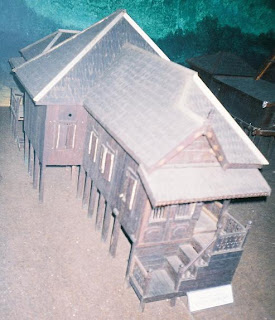
 The black color on the Banjarese house in both South Kalimantan and Banjarmasin's coat of arms represent the high culture of Banjar people. As a Banjarese, it's my duty to appreciate and promote our own heritage. So from now on I will try to write about our culture.
The black color on the Banjarese house in both South Kalimantan and Banjarmasin's coat of arms represent the high culture of Banjar people. As a Banjarese, it's my duty to appreciate and promote our own heritage. So from now on I will try to write about our culture.
For the first article I choose to do an overview of Traditional Architecture of Banjar people, the reason is because I've written parts of the article about this specific matter in Wikipedia, so it's easier for me. These types of houses could still be found in South Kalimantan, but unfortunately they are in a bad shape to say the least. Such a shame, because their existence resonates the glory of our past.
Not only we should preserve it for the sake of our heritage, but because this type of houses was built with great consideration and expertise. Traditional dwellings in Indonesia have developed to respond to natural environmental conditions, particularly Indonesia's hot and wet monsoonal climate. Banjarese traditional vernacular homes are built on stilts. A raised floor serves a number of purposes: it allows breeze to moderate the hot tropical temperatures; it elevates the dwelling above stormwater runoff and mud; allows houses to be built on rivers and wetland margins; keeps people, goods and food from dampness and moisture; lifts living quarters above malaria-carrying mosquitos; and the house is much less affected by dry rot and termites. "Modern" houses which most Banjarese prefer nowadays don't have that kind of sensibility.
In time, Bubungan Tinggi became the symbol of Banjar culture that represents both palace and vernacular traditions. But there are other types of traditional house in Banjarese community other than Bubungan Tinggi. Fortunately, not many Banjarese know these types of house, but it's already explained in old Banjarese poem:
Bubungan tinggi wadah raja-raja, Palimasan wadah emas perak, Balai laki wadah penggawa mantri, balai bini wadah putri gusti-gusti, Gajah manyusu wadah nanang-nanangan, raja-raja atau gusti nanang
 Gajah Baliku: this particular style of house was intended for the closest relatives of the ruler.
Gajah Baliku: this particular style of house was intended for the closest relatives of the ruler. Gajah Manyusu: the type of house of the nobles or "pagustian", the ones who bore the title of "gusti".
Gajah Manyusu: the type of house of the nobles or "pagustian", the ones who bore the title of "gusti". Balai Laki: the type of house for high officials such as the ministers.
Balai Laki: the type of house for high officials such as the ministers. Balai Bini: they type of house for the ladies of the court, such as women of nobility and nannies of the court.
Balai Bini: they type of house for the ladies of the court, such as women of nobility and nannies of the court. Palimbangan: the type of house for high clerics and big merchants.
Palimbangan: the type of house for high clerics and big merchants. Palimasan (Rumah Gajah): this type of house was where gold, silver and other precious belongings kept.
Palimasan (Rumah Gajah): this type of house was where gold, silver and other precious belongings kept. Anjung Surung (Cacak Burung): This is the type of house of commoners. The shape of this house if seen from above is the shape of a cross(+), that is why it is also known as Rumah Cacak Burung.
Anjung Surung (Cacak Burung): This is the type of house of commoners. The shape of this house if seen from above is the shape of a cross(+), that is why it is also known as Rumah Cacak Burung. Tadah Alas: A development of the Balai Bini style.
Tadah Alas: A development of the Balai Bini style. Rumah Lanting: raft house which floats on the rivers of South Kalimantan.
Rumah Lanting: raft house which floats on the rivers of South Kalimantan. Joglo Gudang: This type of house has the roof that is similar to Joglo (Javanese-style house), hence the name. While the name “Gudang” (which means "storehouse") was given because the lower part of the house is usually used to store things. This feature makes this type of house is the preferred style of the Chinese-ethnicity who live in South Kalimantan.
Joglo Gudang: This type of house has the roof that is similar to Joglo (Javanese-style house), hence the name. While the name “Gudang” (which means "storehouse") was given because the lower part of the house is usually used to store things. This feature makes this type of house is the preferred style of the Chinese-ethnicity who live in South Kalimantan. Bangun Gudang: a type of traditional house in South Kalimantan.
Bangun Gudang: a type of traditional house in South Kalimantan.My biggest and endless thanks to Alamnirvana for giving us such precious photos. Semoga tuntung pandang ruhui rahayu, dingsanak lah!







0 comments:
Post a Comment